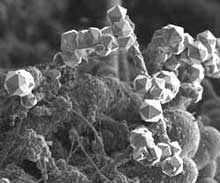Researchers Create Rare, Large Symmetrical Crystals

Accident Leads to Important Discovery
Researchers at Rensselaer Polytechnic Institute in Troy, N.Y., have created large symmetrical crystals that rarely occur in nature. These crystals could be harder than conventional engineering materials. The accidental discovery was made during attempts to make superconducting nanostructures with a simple technique used to create carbon nanotubes.
Pulickel Ajayan and Ganapathiraman Ramanath, faculty members in materials science and engineering at Rensselaer, used boron carbide, a common engineering material, in the high-temperature experiment. In the ashes, they discovered large crystals with five-fold crystallographic symmetry.
Nanosize five-fold symmetrical, or icosahedral, crystals are fairly common, but these larger micron-size crystals with five-fold symmetry are rare in nature because their smaller units cannot repeat their pattern infinitely to form space-filling structures. As the nuclei of these crystals grow, the strain on the crystals increases. This causes them to revert to their common bulk crystal structures.
Ajayan believes that the inherent structure of boron carbide, which has icosahedral units in the unit cell, allows the crystals to grow to micron size without the strain. “These crystals are unique due to their high symmetry. Because of the hardness inherent to the crystal structure, we could anticipate a better material for engineering, specifically coatings. It is exciting and fulfilling to find something that is quite rare in nature, although we need to conduct further measurements to understand its potential,” Ajayan said.
The researchers, their post-doctoral research associates (Bingqing Wei and Robert Vajtai), and a graduate student (Yung Joon Jung) collaborated with colleagues at the University of Ulm in Germany.
Their research appeared as the cover story in the June 13 issue of the Journal of Physical Chemistry.
Rensselaer Polytechnic Institute, founded in 1824, is the nation’s oldest technological university. The school offers degrees in engineering, the sciences, information technology, architecture, management, and the humanities and social sciences. Institute programs serve undergraduates, graduate students, and working professionals around the world. Rensselaer faculty are known for pre-eminence in research conducted in a wide range of research centers that are characterized by strong industry partnerships. The Institute is especially well known for its success in the transfer of technology from the laboratory to the marketplace so that new discoveries and inventions benefit human life, protect the environment, and strengthen economic development.
Media Contact
More Information:
http://www.rpi.edu/dept/NewsComm/All latest news from the category: Materials Sciences
Materials management deals with the research, development, manufacturing and processing of raw and industrial materials. Key aspects here are biological and medical issues, which play an increasingly important role in this field.
innovations-report offers in-depth articles related to the development and application of materials and the structure and properties of new materials.
Newest articles
Humans vs Machines—Who’s Better at Recognizing Speech?
Are humans or machines better at recognizing speech? A new study shows that in noisy conditions, current automatic speech recognition (ASR) systems achieve remarkable accuracy and sometimes even surpass human…

Not Lost in Translation: AI Increases Sign Language Recognition Accuracy
Additional data can help differentiate subtle gestures, hand positions, facial expressions The Complexity of Sign Languages Sign languages have been developed by nations around the world to fit the local…

Breaking the Ice: Glacier Melting Alters Arctic Fjord Ecosystems
The regions of the Arctic are particularly vulnerable to climate change. However, there is a lack of comprehensive scientific information about the environmental changes there. Researchers from the Helmholtz Center…



